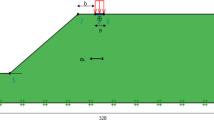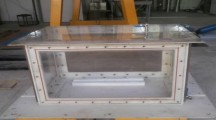Abstract
Various types of slope failure with different ground conditions were analyzed by detailed field investigation of 373 road-cuts along the national highways of Korea. The ground conditions, which are related to failure types and their triggering factors, are strongly dependent upon the weathering or soil depth and fracture intensity in cut slopes. We propose the soil depth ratio (SR) and block size ratio (BR) to define the ground conditions of the cut slopes and to evaluate their instability. SR, which is related to weathering conditions of the ground, is defined as the ratio of soil depth to that of slope height. When SR is greater than 0.4, sliding failure along discontinuities does not occur. BR is defined as the ratio of the block size index to that of slope height. When BR is less than 0.01, behavior of the rock slope shows characteristics of circular sliding even if SR is less than 0.4. Therefore, the ground conditions in cut slopes can be divided into 4 classes based on SR and BR: jointed rock mass (JRM), highly fractured rock mass (HRM), massive rock mass (MRM) and soil-like mass (SLM). This classification provides useful criteria to assess the instability of cut slope composed of various ground materials, and gives some simple rules about instability modes of the cut slopes.
Similar content being viewed by others
References
Einstein, H., H. Veneziano, D., Baecher, G.B. and O'Reilly, K.J., 1983, The effect of discontinuity persistence on rock slope stability. International Journal of Rock Mechanics and Mining Science & Geomechanics, Abstracts, 20, 227–236.
Geological Society, 1977, The description of rock masses for engineering purposes, Quarterly Journal of Engineering Geology, 25, 355–388.
Giani, G.P., 1992, Rock Slope Stability Analysis. Balkema, Rotterdam, 361 p.
Goodman, R.E. and Kieffer, D.S., 2000, Behavior of rock in slopes. Journal of Geotechnical and Geoenvironmental Engineering, 126, 675–684.
Gupta, P. and Anbalagan, R., 1997, Slope stability of Tehri Dam Reservoir Area, India, using landslide hazard zonation (LHZ) mapping. Quarterly Journal of Engineering Geology, 30, 27–36.
Hock, E., 1994, Strength of rock and rock masses, ISRM News Journal, 2, 4–16.
Hock, E. and Bray, J., 1981, Rock Slope Engineering. Institute of Mineral and Metallurgy, London, 309 p.
Hock, E. and Brown, E.T., 1980, Underground Excavation in Rock. Institute of Mineral and Metallurgy, London, 521 p.
ISRM, 1978, Suggested methods of quantitative description of discontinuities in rock masses. International Journal of Rock Mechanics and Mining Science & Geomechanics, Abstracts, 15, 319–368.
Koo, H.B., Jeong, H.I., Jeong, M.K., Ma, S.J., Kim, C.J., Back, Y., Park, H.J., Lee, S.W., Kim, S.W., Kim, D., Kim D.H., Lee, J.H., Seo, K.W. and Park, S.W., 2002, Development and Operation of Road Cut Slope Management System IV. Report KICT-2002-005, Korea Institute of Construction Technology, Ilsan, Korea, 303 p.
Koirala, N.P. and Wakins, A.T., 1988, Bulk appraisal of slopes in Hong Kong. Proceedings of the 5th Symposium on Landslides (Expanded Abstract), Lausanne, July 10–15, p. 1181–1186.
Lee, S.G. and De Freitas, M.H., 1989 A revision of the description and classification of weathered granite and its application to granite in Korea. Quarterly Journal of Engineering Geology, 22, 31–48.
Mazzoccola, D.F. and Hudson, J.A., 1996, A comprehensive method of rock mass characterization for indication natural slope instability. Quarterly Journal of Engineering Geology, 22, 37–56.
Palmstrøm, A., 1996, Characterizing rock masses by the RMi for use in practical rock engineering. Tunnelling and Underground Space Technology, 11, 175–188.
Romana, M., 1993, A geomechanical classification for slopes: Slope Mass Rating. In: Hudson, J.A. (ed.) Comprehensive Rock Engineering, Pergamon Press, London, p. 375–601.
Singh, B., 1973, Continum characterization of jointed rock masses: Part 1-The constitutive equations. International Journal of Rock Mechanies and Mining Science & Geomechanics, Abstracts, 10, 311–335.
Yoon, W.S., Jeong, U., Choi, J.W. and Kim, J.H., 2001, A new index system for slope failure based on ground characteristic: RSFi system. Proceedings of the Young Asian Geotechnical Engineer Conference (Expanded Abstract), Seoul, May 21–23, p. 163–168.
Yoon, W.S., Jeong, U., Choi, J.W., Kim, J.H., Kim, W.Y. and Kim, C.S., 2002, Slope failure index system based on the behavior characteristics: SFi-system. Journal of the Korean Geotechnical Society, 18, 23–37.
Varnes, D.J., 1978 Slope movement types and processes. In: Schuster, R.L. and Krizek, R.J. (eds.), Landslide: Analysis and Control. Special Report 176, Transportation Research Board, National Research Council, Washington, D.C., p. 11–33.
Author information
Authors and Affiliations
Corresponding author
Rights and permissions
About this article
Cite this article
Jeong, U., Yoon, W.S., Choi, J.W. et al. Influence of weathering depth and fracture intensity to cut slope movement. Geosci J 9, 47–52 (2005). https://doi.org/10.1007/BF02910553
Received:
Accepted:
Issue Date:
DOI: https://doi.org/10.1007/BF02910553




